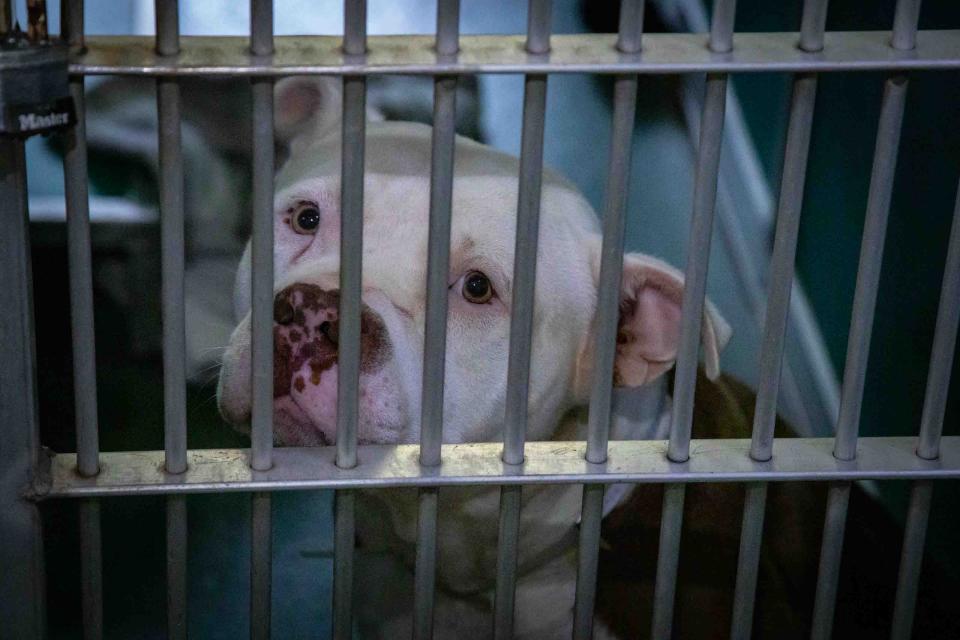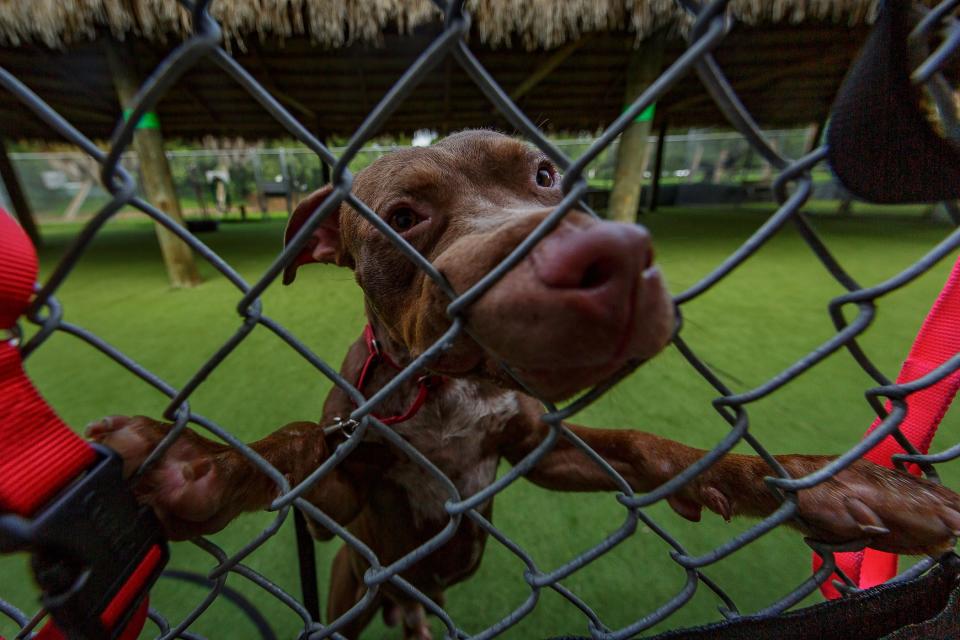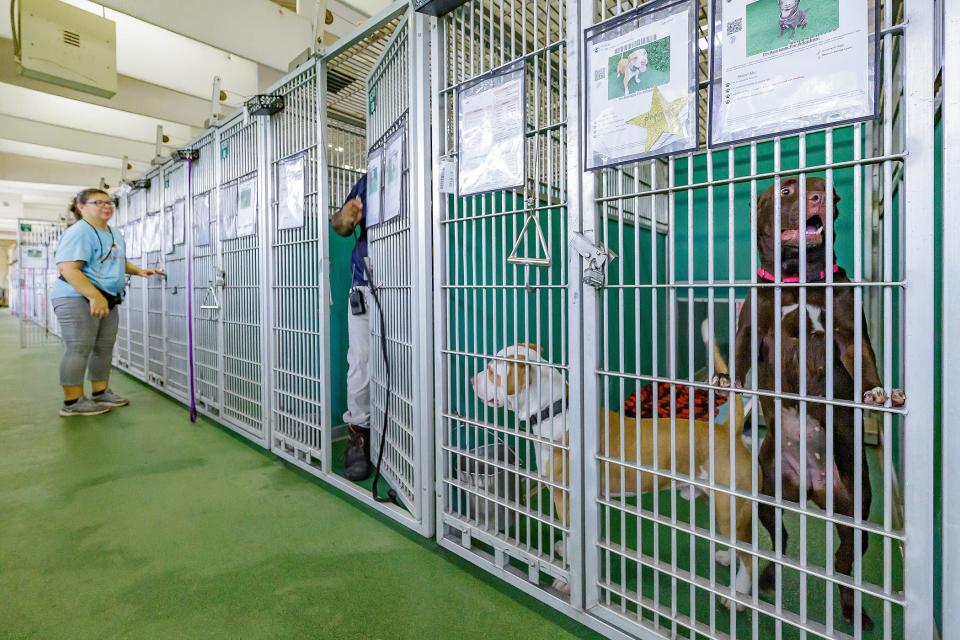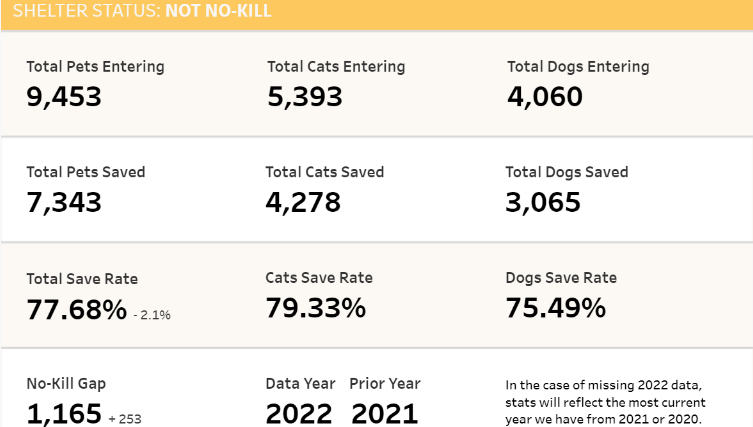An 'emergency situation': Why Palm Beach Animal Control is forced to euthanize so many dogs
WEST PALM BEACH — Overcrowding at Palm Beach County Animal Care and Control has forced some dogs to be euthanized at unprecedented levels to make room for dogs more likely to be adopted, creating what the agency calls "an emergency situation."
The bottom line: Too many people are surrendering dogs and not enough people are adopting them.
Resources are stretched thin, with only 144 available kennels for 192 dogs, the agency reported in mid-August. “The sheer volume of animals is pushing us to the limit. We can't do this alone. Our community's support is vital now more than ever."
Assistant Director Dave Walesky said it is "heartbreaking" to euthanize these dogs, "but we have no choice. There are simply not enough kennels.”
Recently, the Palm Beach County Sheriff's Office brought in 11 pit bulls, Walesky said.
Want to adopt a pet? Need to surrender one? Seven things to know.
“As a publicly funded shelter, we have to accept every pet that is brought to us," he said. "Private shelters can simply decline to accept pets if their kennels are full. We cannot do that.”
Florida ranks fourth among the 50 states for most pets killed in shelters, according to Best Friends, a nonprofit that monitors kill rates at shelters throughout the country. A shelter that can keep its save rate above 85% is considered a no-kill shelter. Last year, Palm Beach County’s Animal Control save rate was 75%, according to Best Friends.
“Every animal shelter in the state is in crisis,” said Heather Smith, a real estate agent who serves as the agency's director of volunteers. “It is not just the kennels that are full. There are not enough volunteers to keep the dogs in good shape so they can be adopted.”
The euthanization of animals: What has caused the situation to become so dire?
It was not that long ago that adoptions of dogs at shelters occurred at record rates. During COVID-19, people flocked to shelters. Videos of empty kennels were commonplace.
But with the cost of caring for dogs skyrocketing and people moving to housing where pets are not permitted, shelters are filled to capacity. And like the Palm Beach County shelter, many are reporting an increase in euthanized dogs. Of 319,077 pets taken in last year in Florida, 20,653 were put down.
Since the Palm Beach County shelter issued its plea for help, Walesky said more dogs have been adopted. As of Aug. 21, 185 dogs were in the shelter. Two months ago, the facility housed more than 230 dogs.

WANT TO ADOPT A PET? Seven things to know before you adopt a pet in Palm Beach County
“We sometimes have had to put two of them into one kennel and had to reduce the size of many of the kennels to accommodate all of them,” said Walesky. “It is not ideal, as it makes it more difficult to prepare the animals for adoption.”
Many animals are taken to a shelter because they were picked up as a stray, surrendered by their owner or rescued from a cruelty case. The dogs most at risk to be put down are those with diseases or those that have behavioral problems.
“Some people get mad at us, but where am I supposed to find the room for the new animals? We have had to put some of them in the manager's office." Walesky said.

Smith said there are so many dogs that not enough of them are walked by volunteers. “It is important that they get out and get the exercise they need," she said.
She noted rescue groups that work with the county shelter are also full, resulting in dogs at the county facility staying for a much longer period.
“These dogs need to go into a home and not just be locked up,” she said. “This is a community issue. As long as people dump their animals and they keep coming in at the same quantity, there is not much that can be done.”
Another issue is the conditions at the county shelter, according to Karen Lambert, a volunteer who appeared before the Palm Beach County Commission on Tuesday to call for air-conditioning. It is almost unbearable in the kennels, she noted.

RELATED: County pet shelters over capacity as rising costs push people to surrender animals
An adoption counselor, T.K. Kirkley, said potential adoptees walk in and walk out, not just because of the heat but the living conditions as well. "It is very sad. Many of the dogs do not have a bed. They sleep on a hard floor."
A renovation project will address some of the issues but that will not take place until 2025. County commissioners Tuesday voted to approve spending $4.2 million to buy 3.2 acres of vacant land adjacent to the shelter. The land will be used for larger animals such as cows, horses and other livestock.
The county staff sees the ability to acquire the land "as a rare opportunity" to allow for future growth and provide the space needed to accommodate the large animals.
The Palm Beach Post analyzed monthly data posted on the animal control agency's website. Comparing May through July 2023 with the same period in 2022, 60% more dogs were put down, 22% more dogs were taken in, 19% more strays were collected and 22% more dogs were surrendered by their owners.

On the positive side was that 379 dogs were adopted, 52% more than the same three-month period in 2022. Walesky attributes the increase in adoptions to the center’s push to make people aware of the overcrowding problem. Even with the significant increase in adoptions, overcrowding is still causing severe problems.
“We still have a long way to go,” he said. To encourage adoptions, the county has waived adoption fees.
Smith is optimistic about the agency's two-month-old Foster 2 Rescue Program, for which the county has partnered with the Peggy Adams Animal Rescue League. A dog is selected and stays in temporary care for up to four weeks before it is transferred to Peggy Adams, where it is placed for adoption.
“We have had 22 dogs so far in foster,” Smith noted. “All were adopted within a week or two.”
Mike Diamond is a journalist at The Palm Beach Post, part of the USA TODAY Florida Network. He covers Palm Beach County government and transportation. You can reach him at mdiamond@pbpost.com. Help support local journalism. Subscribe today
This article originally appeared on Palm Beach Post: Animal Care and Control euthanizes dogs in overcrowding 'emergency'

